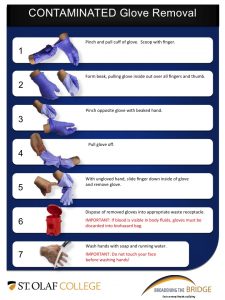The St. Olaf College Exposure Control Plan for Bloodborne Pathogens covers all employees who have, or may have, occupational exposure to bloodborne pathogens in the workplace. The plan promotes safe work practices to minimize the incidence of disease due to bloodborne pathogens.
Questions? Talk with your supervisor or e-mail ehs@stolaf.edu.
OSHA Bloodborne Pathogens Standard
Hepatitis B Virus Vaccination Request Form
Hepatitis B Virus Vaccination Instruction Form
Hepatitis B Virus Declination Form
Hepatitis Vaccination Offered During Initial Hiring
After initial BBP employee training has been completed, the Hepatitis B vaccination series will be made available at no cost to and within 10 days of initial assignment to employees identified in Section 6 (Employee Exposure Determination) this plan.
Vaccination Is Encouraged Unless:
- Documentation exists that the employee has previously received the series.
- Antibody testing reveals that the employee is immune.
- Medical evaluation shows that vaccination is contraindicated (inadvised).
Vaccination Will Be Provided By Allina Health Northfield Clinic
- Allina will also provide information to employees on Hepatitis B vaccinations, addressing the safety, benefits, efficacy, methods of administration, and availability.
- HR will ensure that the health care professional responsible for employee’s Hepatitis B vaccination is given a copy of OSHA’s bloodborne pathogens standard.
- Following the vaccination series, the health care professional’s Written Opinion will be provided to the employee. It will be limited to whether the employee requires the Hepatitis vaccine, and whether the vaccine was administered.
Declining The Vaccination
- If an employee chooses to decline the vaccination, the employee must sign a Declination Form (Appendix C3).
- Employees who decline may request and obtain the vaccination at a later date at no cost.
- Documentation of refusal of the vaccination is kept by HR.
Step 1 (Initial First Aid; Collect the Object)
- Encourage needle sticks and cuts to bleed.
- Gently wash the wound with soap and water for 15 minutes.
- Flush eyes or other mucous membranes (15 minutes) if the exposure was to these body parts.
- Seek medical attention immediately (e.g., have Public Safety call an ambulance).
- Collect the Object
- Contact your supervisor or the CHO; they will arrive with a puncture-proof container to secure the object (which can then be tested for possible infectious agents).
Step 2 (Immediately After Exposure/Suspected Exposure)
The employee shall:
- Immediately contact their supervisor or HR, and inform them of the exposure so that all required steps are followed to ensure the most effective post-exposure medical aid, evaluation, and follow-up (and to ensure that other employees are not at risk of experiencing a similar incident).
- Fill out and submit a First Report of Injury to HR as soon as possible.
- Seek a confidential medical evaluation/consultation and follow-up by employee’s primary health-care physician.
Step 3 (ID the Source of Infection)
HR will work with employee to:
- Document the routes of exposure and how the exposure occurred.
- Fill out the Exposure Incident Report (Appendix D).
- Identify and document the source individual (unless the employer can establish that identification is infeasible or prohibited by state or local law).
Step 4 (Testing the Source of Infection)
HR will:
- Obtain consent and make arrangements to have the source individual tested as soon as possible to determine HIV, HCV, and HBV infectivity.
- Document that the source individual’s test results were conveyed to the employee’s health care provider.
- If the source individual is already known to be HIV, HCV, and/or HBV positive, new testing need not be performed.
Step 5 (Confidential Results to Exposed Employee)
HR will:
- Provide the exposed employee with the source individual’s test results.
- The exposed employee must also understand the information regarding applicable disclosure laws and regulations concerning the identity and infectious status of the source individual (i.e., laws protecting confidentiality).
- Ensure that the health care professional(s) responsible for employee’s post-exposure evaluation and follow-up are given the required information that is documented in Section 10.
- Provide the exposed employee with a copy of the evaluating healthcare professional’s written opinion within 15 days after completion of the evaluation.
Step 6 (Testing Exposed Employee)
HR will:
- After obtaining consent, coordinate the collection of the exposed employee’s blood as soon as feasible after exposure incident to have the blood tested for HBV and HIV serological status.
- If the employee does not give consent for HIV serological testing during collection of blood for baseline testing, preserve the baseline blood sample for at least 90 days; if the exposed employee elects to have the baseline sample tested during this waiting period, coordinate testing as soon as feasible.
Follow this illustrated CDC guide of the proper sequence for donning and doffing PPE.
Contaminated glove removal:

Since there is no way to know the status of body fluids from an unknown source, all human blood and other potentially infectious material (OPIM) must be treated as if known to be infectious for HIV, HBV, or other bloodborne pathogens.
- Follow this mantra: “If it’s wet, and it’s not yours, then don’t get it on you!”
- Gloves will be worn at all times when handling items, cleaning equipment or cleaning up spills, containerizing, or transporting containers (Section 7.6(g)).
- Additional appropriate PPE such as goggles, face mask, and impervious outer clothing is used if splattering is possible.
- Employees shall wash hands immediately after completing the task, in accordance with the hand washing work practices described in Section 7.6(h).
- Dispose of regulated waste only in approved labeled/color-coded biohazard bags or sharps containers (Section 7.10).